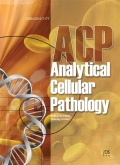Authors: Agelopoulos, Konstantin | Kersting, Christian | Korsching, Eberhard | Schmidt, Hartmut | Kuijper, Arno | August, Christian | Wülfing, Pia | Tio, Joke | Boecker, Werner | van Diest, Paul J. | Brandt, Burkhard | Buerger, Horst
Article Type:
Research Article
Abstract:
Background: Recently, we were able to show that amplifications of the epidermal growth factor receptor (egfr) gene and the overexpression of EGFR were associated with the initiation and progression of phyllodes tumours. Methods: In order to gain further insights into regulation mechanisms associated with egfr amplifications and EGFR expression in phyllodes tumours, we performed global gene expression analysis (Affymetrix A133.2) on a series of 10 phyllodes tumours, of these three with and seven without amplifications of an important regulatory repeat in intron 1 of egfr (CA-SSR I). The results were verified and extended by means of immunohistochemistry using the tissue
…microarray method on an extensively characterized series of 58 phyllodes tumours with antibodies against caveolin-1, eps15, EGF, TGF-α, pErk, pAkt and mdm2. Results: We were able to show that the presence of egfr CA-SSR I amplifications in phyllodes tumours was associated with 230 differentially expressed genes. Caveolin-1 and eps15, involved in EGFR turnover and signalling, were regulated differentially on the RNA and protein level proportionally to egfr gene dosage. Further immunohistochemical analysis revealed that the expression of caveolin-1 and eps15 were also significantly correlated with the expression of pAkt (p<0.05), pERK (p<0.05), mdm2 (p<0.01) and EGF (p<0.001 for caveolin-1). Eps15 and pERK were further associated with tumour grade (p<0.01 and p<0.001, respectively). Conclusion: Our results show that amplifications within regulatory sequences of egfr are associated with the expression of eps15 and caveolin-1, indicating an increased turnover of EGFR. The interplay between EGFR and caveolin-1, eps15, pAkt, mdm2 and pERK therefore seems to present a major molecular pathway in carcinogenesis and progression of breast phyllodes tumours.
Show more
Keywords: Phyllodes tumours, egfr, caveolin-1, eps15
Citation: Analytical Cellular Pathology,
vol. 29, no. 6, pp. 443-451, 2007
Price: EUR 27.50





